

| Home | For sale | Site map | Contact information | Guest book | Lafette-menu |
 The
Lafette 34 & 42 in the postwar era The
Lafette 34 & 42 in the postwar era |
|---|
or
actually...
"The Lafette Recognition Handbook" What is what, and what have I got? 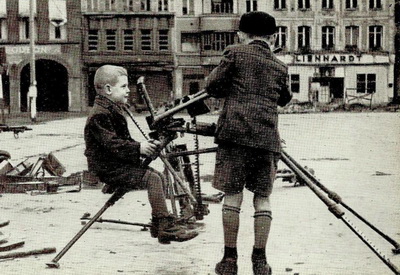 Postwar use. Playing with the spoils of war in a Dutch city in 1944. I never got that expensive toys when I was at that age... This article was created with the help from my friend through many years, Folke Myrvang. His knowledge of the postwar use of the Lafette by different armies was vital to the end result. The original Lafette during the war was a no-brainer in regards to identification, but the postwar use by different armies has complicated this picture. When WW2 ended the left-behind weapons and equipment of the defeated Axis forces were either destroyed or stacked away for later use. These weapons came in handy when the rebuilding of the armies in the different European nations started up again. The MG34 was a complicated weapon, and not as popular as the MG42 post war. Most armies wanted the MG42 or one of its siblings (that would fit in the Lafette 42). This left a situation where most MG34 were disposed of one way or the other, while the matching Lafette 34 was rebuilt for use with the MG42/MG1/MG3/M53/MG74. Due to this fact the postwar rebuilt Lafette 34/42 became more common than the Lafette 42. This page is divided into subsections for each of the countries that used each of the different types of Lafettes. I will focus on which details that tells the actual Lafettes apart, and which country they belonged to. I will try to give some basic guidelines for identification, but remember that the Lafette is made up of a lot of parts, so this can never be an exact science! Keep in mind that the MG42 saw active service on a broad scale in 1943. A Lafette 42 dated 1937 should ring a bell with most two-legged creatures..... When it comes to the paintwork and markings please refer to the corresponding pages about Lafette Paint and Lafette Markings. Definitions To add to the confusion in this postwar minefield I will put my own definitions on the different Lafettes. These may not be valid outside of this page, but to clarify what I mean they will be the guiding light for now.
Lafette 34 The Lafette 34 is easily recognizable by the forward gun mount for the barrel shroud. The Lafette 34 is always "factory made", WW2. No country made them postwar, and they are yet too complicated to be copied. If the main parts match in regards to makers marks (described on the page Markings), you have a WW2 made MG34 Lafette. Postwar refurbished examples do exist, but appears to be rare. Norway The "Norwegian" Lafette 34 was never modified in any way, apart from a new coat of light Olive Drab paint. They always have remnants of the original German color underneath the new paint. The most dominant postwar user of the Lafette 34 seems to have been Norway. Romania A very large percentage of the Lafette 34s in collectors' hands today came from a huge batch of Lafettes imported from Romania through one of the big dealers in the UK in the 1990's. They are stated as all original, except for a postwar green / olive green paint job. The only way to identify them as such is by their condition. They are said to be all "well worn". A large number of these Lafette 34s ended up with Ohio Ordnance. After all the complete mounts had been sold off the remains were sold to Allegheny Arsenal. The lot contained enough spares to piece together quite a few Lafette 34's. These can be recognized by the fact that some of the parts had to be manufactured in order to complete them for sale. Ukraine There is a rumor circulating that Ukraine exported some Lafette 34s together with a batch of de-milled MG34. These Lafette 34s might have been arsenal refurbished and non-matching, but I have never even seen pictures of one. The MG34s from the export are well known in Northern Europe. Portugal 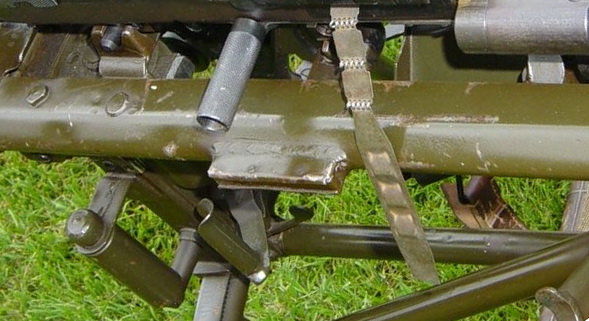 The only country, to my knowledge, that used the Lafette 34 during WW2 and then continued to use it postwar was Portugal. The Portuguese contract Lafettes deviates from the original German WW2 production in a few aspects, so they will be discussed on a page of their own. They can be recognized by their dark olive semi-gloss paintwork and late production date (almost the only Lafette 34’s manufactured in 1943 and 1944). They will also almost always be missing the Überschiess- & Tiefenfeuertafel since these were in Portuguese and later removed by the importers. Lafette 42 The Lafette 42 is rather more complicated to identify. It can be original, rebuilt during the war (see Lafette 34 converted to 42), rebuilt postwar (Lafette 34/42 or Lafette 34/3) or a postwar copy (Lafette 53). The different postwar users all had their own specifications for their Lafettes, making the identification job easier. I will list the special features that should enable you to identify the former nation that used it. 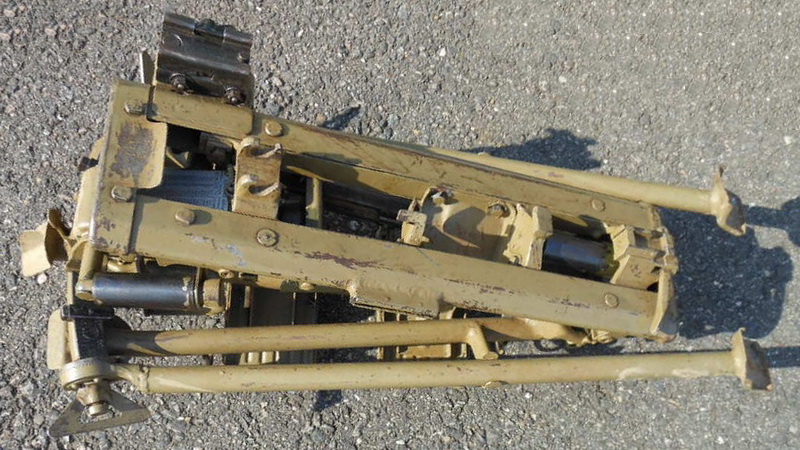 A tricky one. This one has been tampered with to "improve" it, but the canvas pads and the cap of the oil brush give it away as pre-Yugoslavian, while the conversion from Lafette 34 to Lafette 34/42 was done during the war by a Waffenmeister. Who can spot the part from 1936/1937? Norway The Lafette 34/3s used postwar in Norway are all surplus Lafette 34s rebuilt to accept the MG3. These are easy to spot by the following details:
The Lafettes were rebuilt at "Marinens Verft, Horten" (The Navy's shipyard in Horten) for the then newly acquired MG3's of the Norwegian army. The rebuilding process also included the removal of the bolt box, a simplified trigger copied from the Lafette 42, repainting the Lafette 34/3 OD and attaching covers of black faux leather over the original leather pads. The original leather pads were left intact underneath the new ones. 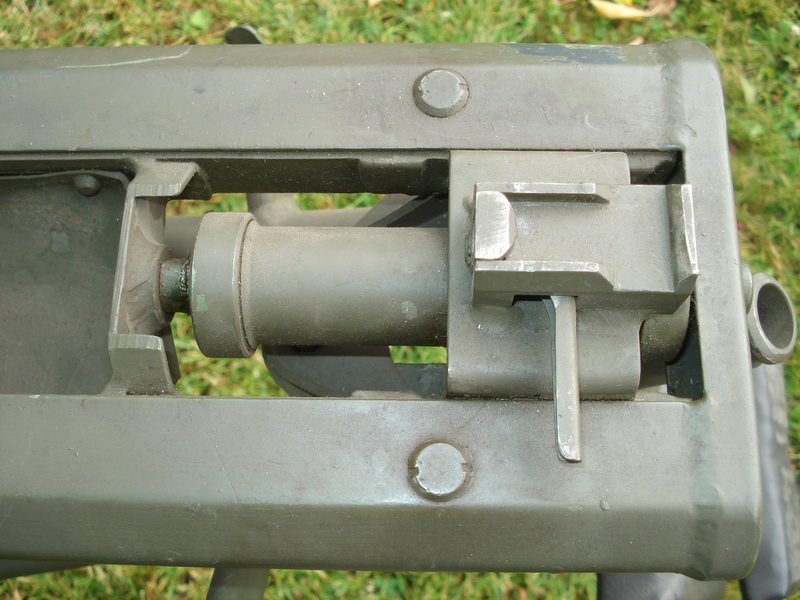 The
Norwegian converted Lafette 34/3 for the MG3. Note the cut-off rear
buffer
mount and the remnants of the MG34 forward weapon mounts still welded
to the inside of the cradle.
Bundesrepublik Deutschland The Lafette 42 saw use in the early days after the war within the German Bundesgrenzschutz (BGS), a border Polizei unit established in 1951. These Lafettes were used with the MG42 and later also the MG1 and MG3. They have no special modifications, apart from the fact that they are painted in a very special funky green semi-gloss paint, the "Polizei-grün". They are all original MG42 Lafettes. Austria Austria had their fair share of Lafettes lying around the place after the war as well. Some were original Lafette 42s and some were Lafette 34s. The Lafette 34s were all rebuilt to Lafette 34/42s. The forward gun mount on these are an almost exact copy, but some of them (not all!) are marked with a multi-digit stock number to the center of the top section. The rear cover has been rebuilt to the lower-side release-lever type by welding shut the opening on top, and the rear buffer mount has either been totally replaced with a new Lafette 42 type or kept as is. They can be identified by the rear cover markings (dated prior to 1943), the rear buffer mount (if not altered) and the rear weapon mount with the MG34 type cuts.
Common
for the Lafette 34/42 and Lafette 42 in Austrian postwar service was
the
refurbishing process. They were sandblasted in one piece, so the
original German color is possible to spot in hidden places, like under
the bolt box and inside the cradle ends. The Laying- &
Search
fire mechanism was kept as-is and repainted, stripped like the
rest and painted again or simply painted black. The rest of the Lafette
has been
cleaned down to the metal prior to receiving a flimsy coat of light
grey-green. There are two tell-tale signs that disclose them
as Austrian refurbs: They have a Austrian eagle and BH
(Bundesheer) stamped on the forward weapon mount, and they have a lever
welded on the Search fire mechanism to enable
the gunner to finely adjust his fire manually.
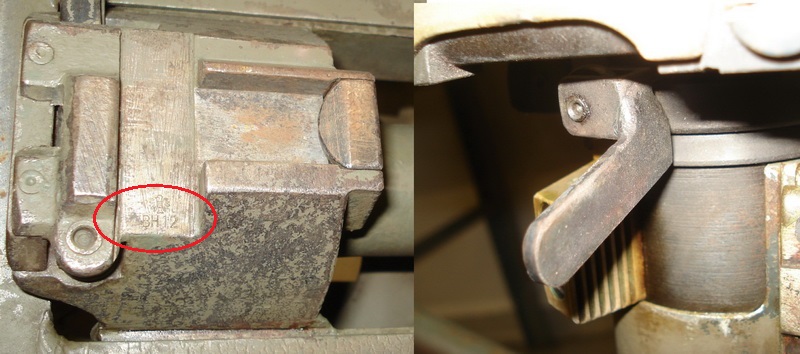 In
addition most Austrian Lafettes have had the pads renewed with brown
leather ones resembling the originals, but not quite identical. Another
consistent thing about these Lafettes is the fact that the height
adjustment wheel is black (!?).
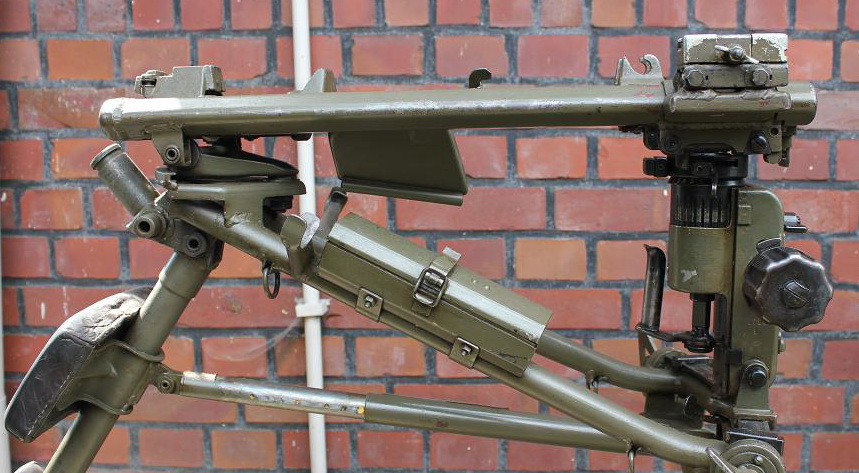 A typical Austrian refurbed original Lafette 42. Note the leather pads, with a slightly too greasy appearance, the black hand wheel and the lever welded on the Search fire mechanism. This one also sports the Austrian bolt box, easily recognized by the solid locking lever. This type of locking lever can only be found on Austrian postwar made replacement bolt boxes, initially made for the converted Lafette 34/42s, but also as replacement parts. Unfortunately, a lot of these boxes have also found their way from Ebay to numerous Lafettes. Yugoslavia The most readily available Lafettes today are those that came out of the former country of Yugoslavia. They continued to use the Lafette 42 postwar and they converted most of their stock of Lafette 34s to Lafette 34/42s in order to accept the MG42/53. In addition they also reverse-engineered the Lafette 42 and made a copy of it designated the "Puškomitraljezi M53". In order to try to keep our sanity we will refer to it as the "Lafette 53" from now on.
The Lafette 53 was such a good copy that the parts are actually interchangeable with the Lafette 34 & 42. This represents a problem, since the Yugoslavians ran a heavy refurbishing procedure with the end result of very mixed up Lafettes. It is not uncommon to find Lafette 53s with WaA parts and also the other way around.
The common feature of the Yugo Lafettes is the data plate riveted to the rear cover. This would obliterate the German markings (when present), and would not actually boost sales of these Lafettes, so it is now very rarely found at all. Most being removed by the importers before the Lafettes even reached the resellers. But the four holes left by the rivets is a tell-tale sign of the Lafettes history. If the 4 holes are present you can be sure the Lafette is pre-Yugo used. But remember that the holes can also be welded shut…
Three
ex-Yugo Lafettes. The first is a Lafette 34/42,
the second is a Lafette 53 with welded holes and fake marking and the
third is a Lafette 53 with the correct blank rear cover, missing the
data plate.
The refurb program carried out on the original Lafettes broke them down to components before reassembly, and the markings & makers did not play a role in this process. The result is that the Yugo Lafettes are consistently heavily mixed up both in regards to makers and time-periods of the individual parts. Due to this it is almost impossible to tell anything apart, as a lower tripod from a Lafette 42 could well be mated to an upper tripod from a Lafette 34 (converted to take the M53) with the rear cover from a Lafette 42. Absolute chaos is often the result....
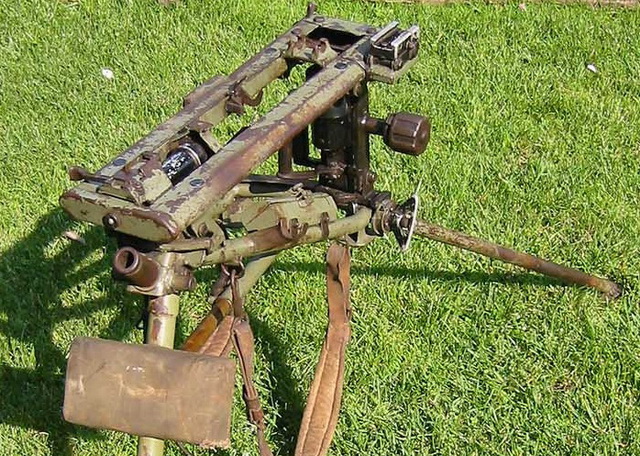 Lafette 34 sleighs converted to Lafette 34/42 can be recognized by the MG34 rear weapon mount with cuts, and the rear buffer mount for the MG34. The front weapon mount is a replica of the original MG42 mount, and has replaced the MG34 weapon mount. 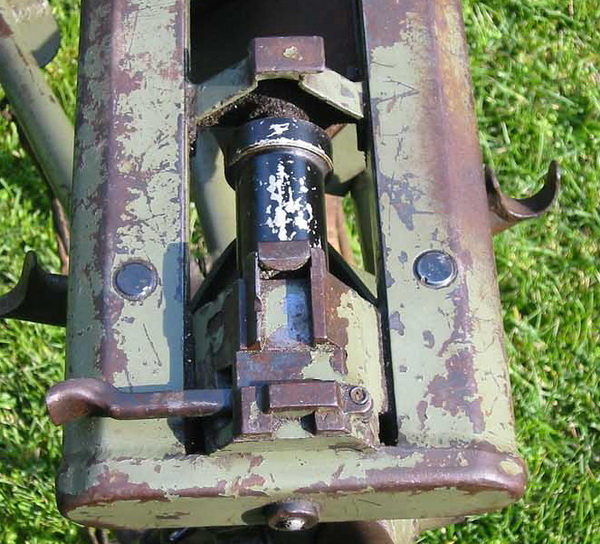 A Yugo jackalope! A MG34 cradle with the rear buffer mount intact (MG34 style) and a new made MG42 front gun mount clone welded in.
With the M53 machine gun the need for more Lafettes terminated in the production of the Lafette 53. It is identical to an early production Lafette 42 in most aspects, so let’s focus on the visible differences. The Lafette 53
All markings on the Lafette 53 can be found on the data plate riveted on to the rear cover. With this missing, the Yugo markings are for the most part also gone. The only exceptions are some small control stamps from the manufacturing process scattered around. The example above has a rear cover without any markings, with the four holes from the missing data plate. The Lafette 53 came in two versions; with or without the optic mounts. The example above is manufactured without the optic mount. Telling the Lafette 53 and Lafette 42 apart It is actually rather easy to tell the the two apart, if you are armed with the right knowledge. The Lafette 53 was never manufactured to fool anyone. The original was a good invention, so no need to alter the copy I guess. But there are a few tell-tale signs on the Lafette 53 that sets it apart from its older brother. Keep in mind that a Lafette 53 will never be worth anything close to a Lafette 42, so it will always be tempting to fix and alter on these in order to present them as "the real deal". In the following section I have tried to compare pictures of Lafette 53 on the left with pictures of an original Lafette 42 to the right. Lets
list the obvious:
The rear weapon mount has a different shape, with a more angled back and a flatter top than the German original.
The D-rings for the carrying straps have a strange shape, not resembling their German WW2 counterpart.
The Laying- & Search fire mechanism is unmarked on the left side (but could be beefed up with fake marking), and is always blued or painted black with a black or silvery Yugo range plate (or missing/replaced plate). The oil brush top is also different.
The rear buffer mount on most Lafette 53 has a distinctly shaped profile that is very different from the Lafette 42. The shaped profile is a sure sign of a Lafette 53. It was never manufactured like that in Germany. The optics block and buffer are both made of blackened aluminum, unlike the German WW2 green or brown /yellow finish. The Optic block lacks the WaA, and the wing nut lacks the raised "M" that can be found on its German counterpart. On the Lafette 34/42s the aluminum parts appears to have been painted black.
The back pads for the Lafette 53 are normally made of canvas, but examples in leather have been observed as well. German pads were never manufactured in canvas. There
are certainly a number of other differences between the original
Lafette 42 and the Lafette 53, but armed with the knowledge
above it should be pretty easy to tell
them apart. Read also the articles about paint and markings, as
the Lafette 53 is featured in both of them. How
to tell the front weapon mounts apart
|
||||||||||||||||||||||||||||||||||
| Home | For sale | Site map | Contact information | Guest book | Lafette-menu |